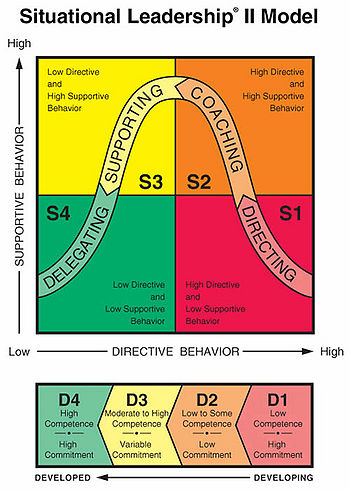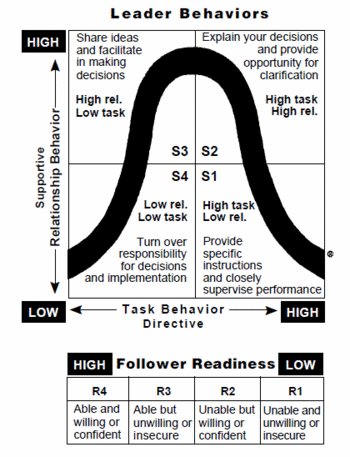Situational Leadership II
(→Leadership Styles) |
(→Leadership Styles) |
||
| Line 40: | Line 40: | ||
| Senior-level staff | | Senior-level staff | ||
|- | |- | ||
| − | | | + | | Dependent, they direction and quick feedback. |
| − | | | + | | Interested, motivated, the leader is more coaching than directing. |
| − | | | + | | Involved, they limited support for decisions and deliveries. |
| − | | | + | | Self-directed, they just need to be assigned for a project. |
|- | |- | ||
|} | |} | ||
Revision as of 11:36, 23 September 2017
As it is widely known many engineers do not receive management education. Based on their technical skills they positioned to lead or manage people and projects regarding the work and knowledge that they have. Situational leadership can help engineers become successful managers and enable them diagnose their working environment.
The Situational Leadership theory introduced by Paul Hersey and Kenneth H. Blanchard (1974,1982). The revised model Situational Leadership II appeared was published in January-March 1985. The idea behind it, is that the most effective leadership style is situational-specific. They argued that when the situation is changing (people involved in the project), the leadership style that it is applicable will have differences from the the one used efficiently before (Ronald K. Hambleton and Ray Gumpert, 1982).
The management concept of Situational Leadership is introduced in order to help people be more effective in their everyday interactions. Another ingredient in their theory is that the leadership style needs to differ regarding the given task that needs to be done and the maturity level of the group or the individual.
Situational Leadership is about training managers to identify the advantages and disadvantages of each style, and how they can implemented in different work situations. As Carmen Cirstea and Dumitru Constantinescu mentioned; it is vital for managers to be able to identify their intrinsic leadership style, as intrinsically they return in that style on periods of stress.
As leadership is an act from people to the people, it is important to know your people and Paul Hersey and Kenneth H. Blanchard made a model in order to help people, but also, the leaders to successfully deliver a given task. This article will present, review, and also, discuss the implementation of Situational Leadership II in projects.
Contents |
Application of Situational Leadership II
Directive/Supportive Dimensions
The two axis in Paul Hersey's and Kenneth's H. Blanchard model are illustrating the amount of Direction (Relationship Behavior) and Support (Task Behavior) that the follower needs in order to successfully deliver a specific task.
Leadership Styles
Depending on the amount of Support and Direction that the follower needs, leadership styles fall into four categories (different resources have used different names for four categories, in this article the categories will be named regarding the amount of the Direction/Support (Relationship/Task).
| S1: High-task/low-relationship leader behavior | S2: High-task/high-relationship leader behavior | S3: High-relationship/low-task leader behavior | S4: Low-relationship/low-task leader behavior |
|---|---|---|---|
| One way communication, the leader decided on what,how, when and where the follower will execute the specific task. | Almost one way communication, the leader supports the follower socio-emotional, and trying to put him psychologically into the decision making. | Two way communication, the leader and the follower contribute together in the decision making. The follower is capable to deliver successfully the given task. | The follower is high in readiness, have great ability and willing. In this case the leader needs to delegate and allow the follower behave with self-direction. |
| Junior stuff or newly involved with the specific situation | Mid-level staff | Senior-level staff that needs support | Senior-level staff |
| Dependent, they direction and quick feedback. | Interested, motivated, the leader is more coaching than directing. | Involved, they limited support for decisions and deliveries. | Self-directed, they just need to be assigned for a project. |

